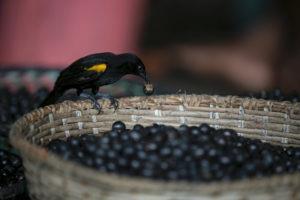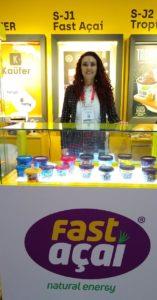(MENAFN- Brazil-Arab News Agency (ANBA))

São Paulo – Açaí berry is the flagship of the Brazilian space at Gulfood 2022 . More than that, the fruit is brought as a national symbol of the country. The unique strategy for the Amazonian fruit was devised by the Brazilian Trade and investment Promotion Agency (Apex-Brasil) this year to link its image to the country. The show is taking place in Dubai until February 17 and is the most considerable for the sector in the entire Middle East. Pictured above, açaí berries.
Despite gaining the taste of the Gulf, consumers in the region are still not sure about the origins of the product, which has its roots in the Amazon region.“Açaí is a typical Brazilian product, which many consumers still do not associate with the country. So, we have to work on that image. And it is a product that undergoes an interesting improvement until it reaches the final consumer. It is an excellent example of a fruit which achieved a fascinating advance in exports, including to the MENA region,” pointed out the COO of the Apex-Brasil office for the Middle East and North Africa (MENA), Karen Jones.
Origins
The production of at least three of the companies exhibiting at Gulfood comes from the state of Pará. Pará is the main açaí producing state in the country and has doubled its production from 2009 to 2019, according to data from the Brazilian National Supply Company (CONAB).
In the country's northern region, açaí is a staple food in meals such as lunch and dinner. In other regions of Brazil and abroad, the fruit began to be consumed mainly as a dessert or a healthy energy source.
Where it came from and where it is going

Petruz is a family company that produces and exports açaí
Among the brands from Pará already present in Dubai is Petruz Fruity . Founded in 1982 in the municipality of Castanhal, the company has been exporting since 2006. It already sells to Saudi Arabia, Bahrain, Abu Dhabi, and more traditional fruit destinations such as the United States and European Union. With the participation in Gulfood, the company hopes to double its sales.
As one of the veterans in the market, Petruz followed the growth in demand for the fruit in the Gulf.“Initially, people looked at the fruit, the color, and said, 'what is this?' Today, the popularity of açaí has grown a lot. People now understand this is a superfood, which is healthy for us and the Amazon rainforest,” explained Martin Chavez, international director of the brand.
Also based in Castanhal, Xingu Fruit wants to open a market in the UAE for its brand. Although it already has its raw material in the Arab country's market through a private label, Xingu still does not have its brand stamping items on supermarket shelves or local coffee shops.“The company opened in 2017, but the owner already had a great knowledge of the açaí market, and we have already started exporting,” says Suany Gomes, the brand's export manager.

Xingu açaí continues to have Brazil as its primary market
Today, Xingu sells 25% of its açaí abroad, and the domestic market purchases the other 75%.“We supply virtually all Brazilian states. Brazil is still the biggest market for açaí, and we observe around 40% to 50% growth every year,” she said.
The company has participated in the show for four years and is now looking to open businesses to sell pulp and açaí sorbet.“We have great growth expectations, and we can even see them through Gulfood itself. Last year, we came, but the show was quite different. I think with things coming back to normal a little more, this will be much more positive for us,” she concluded.
Fast Açaí , on the other hand, is headquartered in the Brazilian Midwest but also has production coming from Pará.“We are in Goiânia, and we have a partner company in Belém, which extracts the fruit and processes it,” said Walesca Rocha, the brand's foreign trade manager.

Fast Açaí has stores all over Brazil
In addition to its product, the enterprise makes custom ones for other brands and has around 200 franchise units all over Brazil. For six years, the company has been exporting to markets like the United States, Angola, and South Africa.“We have a strategic expansion plan here in the UAE for this year, and that is our goal at the show,” she said.
For Rocha, açaí is already in the minds of consumers in different countries, but in its own way in each one.“It really depends on the location. In California, for example, they know açaí is a Brazilian product and its properties and that it is a meal replacement. In South Africa, açaí is seen as a combo, for example, a salad and a bowl of açaí,” she explained regarding consumption of the Brazilian product abroad.
In addition to other açaí companies at the Brazil Pavilion, Tropicool is also at the Arab Brazilian Chamber of Commerce (ABCC) booth. The Brazilian company is already in the Arab market and even has a kiosk in the world's largest shopping mall, Dubai Mall.
Quick facts:
Gulfood 2022
February 13 to 17, 2022
WTC, Dubai, United Arab Emirates
More info:
Translated by Elúsio Brasileiro
©Tarso Sarraf/AFP
Thais Sousa/ANBA
Thais Sousa/ANBA
Thais Sousa/ANBA
The post From Pará to Dubai: Brazilians show origins of açaí berry appeared first on Agência de Notícias Brasil-Árabe .
MENAFN13022022000213011057ID1103689329
Legal Disclaimer:
MENAFN provides the information “as is” without warranty of any kind. We do not accept any responsibility or liability for the accuracy, content, images, videos, licenses, completeness, legality, or reliability of the information contained in this article. If you have any complaints or copyright issues related to this article, kindly contact the provider above.